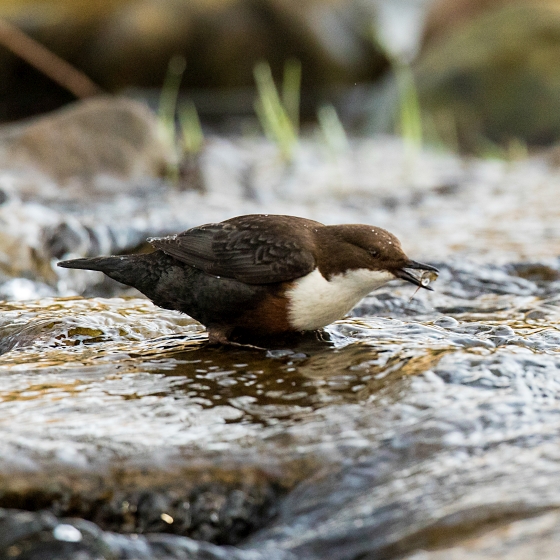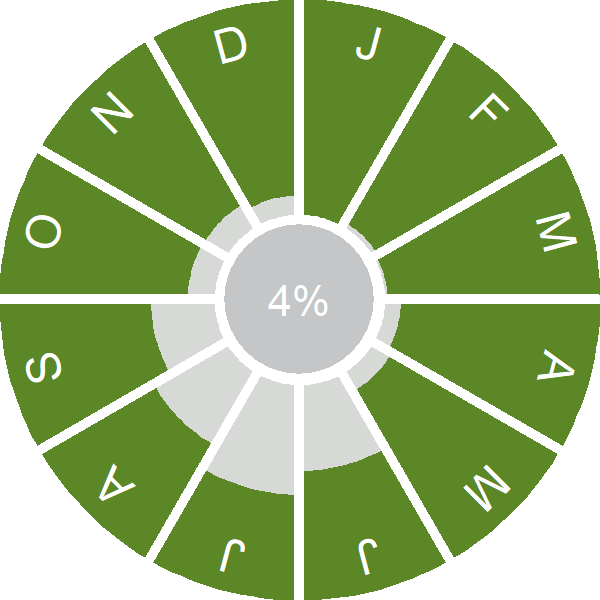Dipper
Cinclus cinclus (Linnaeus, 1758)
DI
 DIPPE
DIPPE  10500
10500

Family: Passeriformes > Cinclidae

These aquatic birds are unique among British & Irish passerines, foraging underwater for small invertebrates in fast-flowing streams.
Dippers are primarily found year round in northern and western Britain, and much of the island of Ireland. In winter, individuals may be reported further east, but this part of Britain lacks suitable Dipper breeding habitat. Although UK Dipper numbers have fluctuated in recent decades, there is an overall downward trend, and this species is on the UK Amber List.
Adult Dippers are primarily dark brown in appearance, with a white throat and chest. They can often be spotted, tail cocked, standing on a stone in fast, shallow streams, from where they will either walk into the water to hunt their invertebrate prey, or fly low to the surface to another perch, with a rapid wingbeat. Breeding pairs will defend a territory along a stretch of water. Juveniles Dippers have a more mottled, grey appearance.
Exploring the trends for Dipper
Our Trends Explorer will also give you the latest insight into how the UK's Dipper population is changing.
trends explorerIdentification
Dipper identification is usually straightforward.
SONGS AND CALLS
Listen to example recordings of the main vocalisations of Dipper, provided by xeno-canto contributors.
Begging call
Song
Develop your bird ID skills with our training courses
Our interactive online courses are a great way to develop your bird identification skills, whether you're new to the hobby or a competent birder looking to hone your abilities.
Browse training coursesStatus and Trends
Population size and trends and patterns of distribution based on BTO surveys and atlases with data collected by BTO volunteers.
CONSERVATION STATUS
This species can be found on the following statutory and conservation listings and schedules.
POPULATION CHANGE
The WBS/WBBS shows that Dipper populations have fluctuated over the last thirty years, with a general downward trend. Through its strengthening UK breeding decline, the species was moved from green to being amber listed in the latest review (Eaton et al. 2015).
| UK breeding population |
-50% decrease (1995–2022) 
|
Exploring the trends for Dipper
Our Trends Explorer will also give you the latest insight into how the UK's Dipper population is changing.
trends explorerDISTRIBUTION
Dippers are exclusively associated with fast-flowing, stony-bottomed watercourses, whether in winter or in the breeding season. They are widespread throughout non-coastal areas in Scotland, Wales, northern and southwestern England, and absent from low-lying areas of central, south and eastern England. Densities tend to be relatively high in Scotland, northern England and the southern half of Wales.
Occupied 10-km squares in UK
| No. occupied in breeding season | 1402 |
| % occupied in breeding season | 46 |
| No. occupied in winter | 1459 |
| % occupied in winter | 48 |
European Distribution Map
DISTRIBUTION CHANGE
Breeding range changes since the 1968–72 Breeding Atlas in Britain have been slight (-11%). Small losses in northern and western Scotland may be related to acidification problems from conifer plantations. Farther south, it is notable that losses have taken place on the eastern fringe of the range in Wales and southwest England.
Change in occupied 10-km squares in the UK
| % change in range in breeding season (1968–72 to 2008–11) | -11% |
| % change in range in winter (1981–84 to 2007–11) | +14.6% |
SEASONALITY
In suitable locations Dipper is recorded throughout the year.

Movement
Information about movement and migration based on online bird portals (e.g. BirdTrack), Ringing schemes and tracking studies.
RINGING RECOVERIES
View a summary of recoveries in the Online Ringing Report.
Foreign locations of birds ringed or recovered in Britain & Ireland

Biology
Lifecycle and body size information about Dipper, including statistics on nesting, eggs and lifespan based on BTO ringing and nest recording data.
PRODUCTIVITY & NESTING
Exploring the trends for Dipper
Our Trends Explorer will also give you the latest insight into how the UK's Dipper population is changing.
trends explorerSURVIVAL & LONGEVITY
View number ringed each year in the Online Ringing Report
Maximum Age from Ringing 
|
8 years 9 months 6 days (set in 2017) 
|
Typical Lifespan 
|
3 years with breeding typically at 1 year |
Adult Survival 
|
0.54  
|
Exploring the trends for Dipper
Our Trends Explorer will also give you the latest insight into how the UK's Dipper population is changing.
trends explorerBIOMETRICS
Wing Length 
|
Adults | 92.6±4.8 | Range 86–100mm, N=388 |
| Juveniles | 93.3±4.4 | Range 86-99mm, N=133 | |
| Males | 97.3±2.1 | Range 93.5–101mm, N=160 | |
| Females | 88.8±2.3 | Range 86–92mm, N=204 |
Body Weight 
|
Adults | 63.7±6.3 | Range 54.0–73.8g, N=340 |
| Juveniles | 62.9±6 | Range 54.0–73.0g, N=127 | |
| Males | 68.5±4 | Range 62.0–74.0g, N=139 | |
| Females | 59.9±5 | Range 52.5–69.0g, N=180 |
Feather measurements and photos on featherbase 
CODES & CLASSIFICATION
Ring size 
|
CC |
Field Codes 
|
2-letter: DI | 5-letter code: DIPPE | Euring: 10500 |
For information in another language (where available) click on a linked name
Research
Interpretation and scientific publications about Dipper from BTO scientists.
CAUSES AND SOLUTIONS
Causes of change
The drivers of change for Dipper are unclear; however breeding productivity has risen so it is unlikely that problems during the nesting stage have contributed to the observed declines.
Further information on causes of change
The species is unusually sensitive to acidity and other water-borne pollution (Ormerod & Tyler 1989, 1990), with lower breeding densities and productivity on acidic than on more neutral streams (Ormerod et al. 1991, Vickery 1991, 1992). Breeding performance has improved strongly over time, and laying dates have shifted earlier, perhaps because of climate change (Crick & Sparks 1999). Broods now average larger than in the late 1960s and 1970s, and there has been substantial reduction in failure rates of nests at the egg stage, leading to sustained increase in the number of fledglings per breeding attempt. In a river system in southern Norway, climate variables including winter temperature explained 84% of the variation in population level during 1978-2008 (Nilsson et al. 2011). Thus, some of the UK fluctuations may relate to winter weather.
Information about conservation actions
The drivers of change are unclear, but are unlikely to be due to problems during the breeding season and fluctuations in abundance could relate mainly to winter weather. However, Dippers are sensitive to acidity (see Causes of Change section, above) and therefore conservation actions which protect rivers from pollution and which ensure they do not become more acidic are likely to help to ensure that conditions remain optimal for Dippers.
Links to more studies from ConservationEvidence.com
Would you like to search for another species?












Share this page